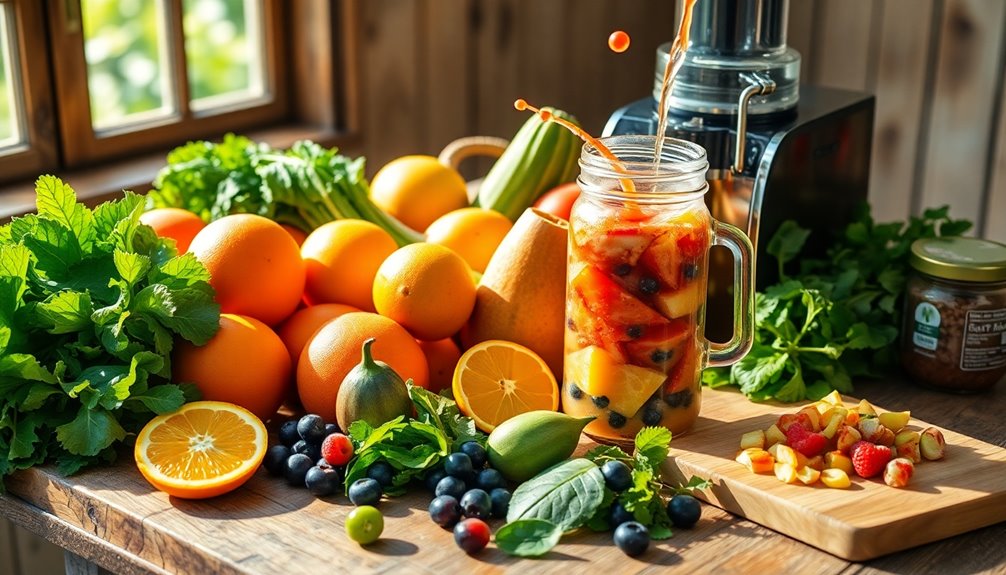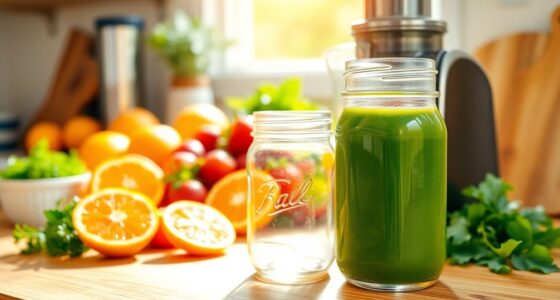Making homemade organic juices is easy and rewarding! Start by gathering your equipment, then select fresh fruits and vegetables. Prepare your produce by washing and cutting it into chunks. Choose your juicing technique, whether it’s a centrifugal or cold press juicer. Blend your ingredients, strain if desired, and store your juice in airtight glass containers. Enjoy your refreshing creations daily, and don’t forget to experiment with new recipes for exciting flavors and health benefits waiting to be discovered! As you become more comfortable with the juicing process, consider exploring various homemade organic juice recipes that incorporate unique combinations of fruits and vegetables. For instance, try adding leafy greens like kale or spinach for an extra nutrient boost, or experiment with herbs such as mint or basil to add a refreshing twist. Sharing your favorite homemade organic juice recipes with friends and family can turn your juicing hobby into a fun and healthy gathering, inspiring others to join you on your journey toward wellness!
Key Takeaways
- Select fresh, organic fruits and vegetables, ensuring variety for balanced flavors and nutritional benefits.
- Wash, peel, and prepare produce by cutting into manageable pieces for efficient juicing.
- Choose the right juicing equipment, like a masticating or cold press juicer, to retain nutrients.
- Strain juice using fine-mesh sieves or cheesecloth for a smoother texture before storing.
- Store juice in airtight glass containers in the fridge, or freeze in small portions for later use.
Gather Your Equipment
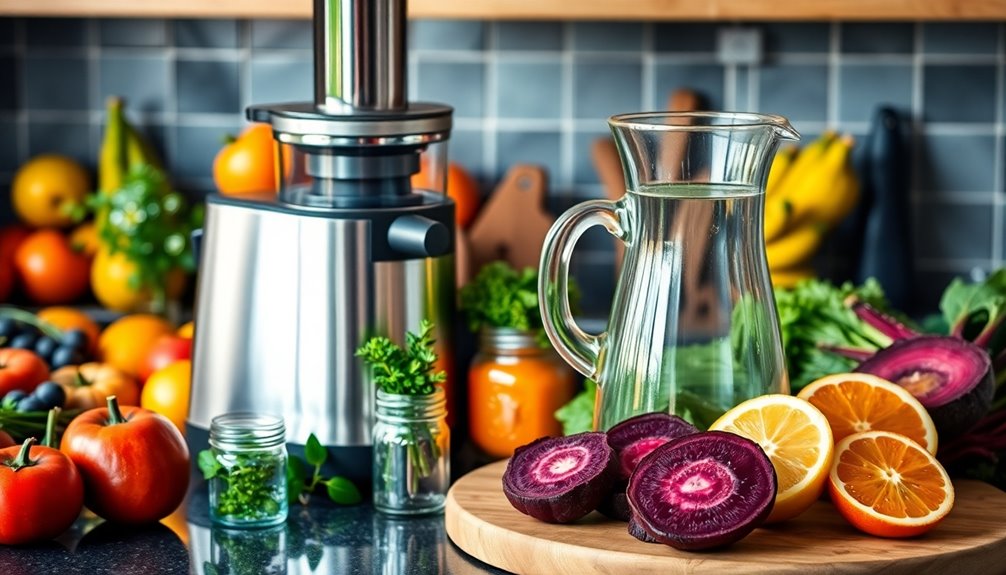
When making DIY organic juices, the right equipment can make all the difference in your experience and results.
Start by choosing the right juicer. Cold press juicers preserve nutrients best, while centrifugal juicers work quickly but can generate heat. If you want versatility, masticating juicers handle leafy greens well. For smaller batches, manual juicers are cost-effective. Using a cold press juicer can significantly enhance the nutrient retention in your juice.
Blenders and food processors can also do the trick if you strain the mixture afterward. Don't forget straining tools like fine-mesh sieves or cheesecloth to remove pulp. Additionally, using fresh fruits allows for higher nutrient retention and a more flavorful juice.
Store your juice in glass containers or mason jars, and consider ice trays for freezing. Finally, gather additional accessories like measuring cups and cutting boards to streamline your juicing process.
Select Your Ingredients
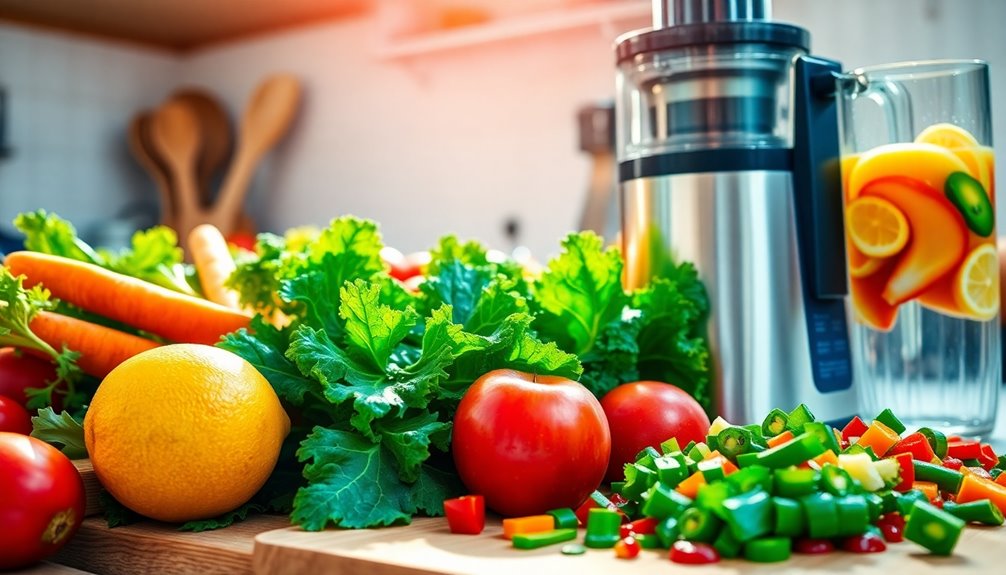
Now that you've gathered your equipment, it's time to select your ingredients for the perfect organic juice. Start with fruits like apples for sweetness, grapes for natural flavor, and berries for their vibrant colors and antioxidants. Citrus fruits, such as oranges and lemons, add a zesty kick, while peaches contribute a smooth texture. For vegetables, consider leafy greens like spinach and kale, which pack a nutritional punch. Carrots and celery add natural sweetness and crunch, while beets offer an earthy depth and are known to improve blood flow. Don't forget herbs and spices! Ginger gives a spicy kick, and mint adds refreshing notes. You can sweeten your juice with honey or agave nectar for a natural touch. Choose wisely, and your juices will shine! Additionally, incorporating vitamin C-rich ingredients will boost the nutritional value of your juice.
Prepare Your Produce
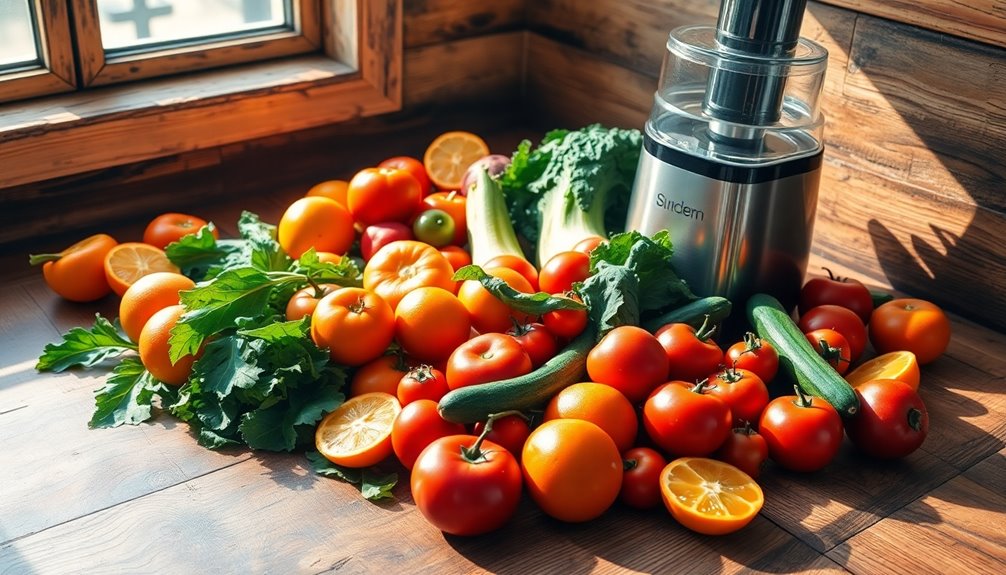
To get the most out of your organic juices, preparing your produce properly is essential. Start by thoroughly washing your fruits and vegetables to remove dirt and bacteria. If you're using non-organic produce, peel it to avoid pesticide residues; organic items can often be juiced with peels on. Trim the ends of root vegetables like carrots and beets, and remember to pat everything dry to prevent juicer damage. For leafy greens, keep the stems, as they contain vital nutrients. Citrus fruits should be peeled to avoid bitterness, while ginger and turmeric can be juiced with peels after proper cleaning. Additionally, removing large seeds helps avoid bitter flavors and protects your juicer blades. It's also beneficial to incorporate organic fruits and vegetables for the best nutrient extraction. Lastly, cut your produce into manageable chunks for efficient juicing, ensuring you've got a clean and fresh setup for your delicious blends!
Choose Your Juicing Technique

Choosing the right juicing technique can significantly impact the quality and nutritional value of your juice. If you're after speed, centrifugal juicers are quick but may compromise nutrients due to heat and oxidation. For better nutrient retention, consider masticating juicers, which extract juice slowly and are excellent for leafy greens. A two-step juicing process, which combines blending and hydraulic pressing, can optimize juice yield and quality. Additionally, the use of cold press juicers can help maintain the integrity of essential vitamins and minerals. If you want the best of both worlds, twin-gear juicers minimize oxidation while maximizing nutrient preservation. Cold press juicers also excel at this but take more time. You might even explore hybrid methods that combine blending with pressing for enhanced yield.
Create Your Juice Blend
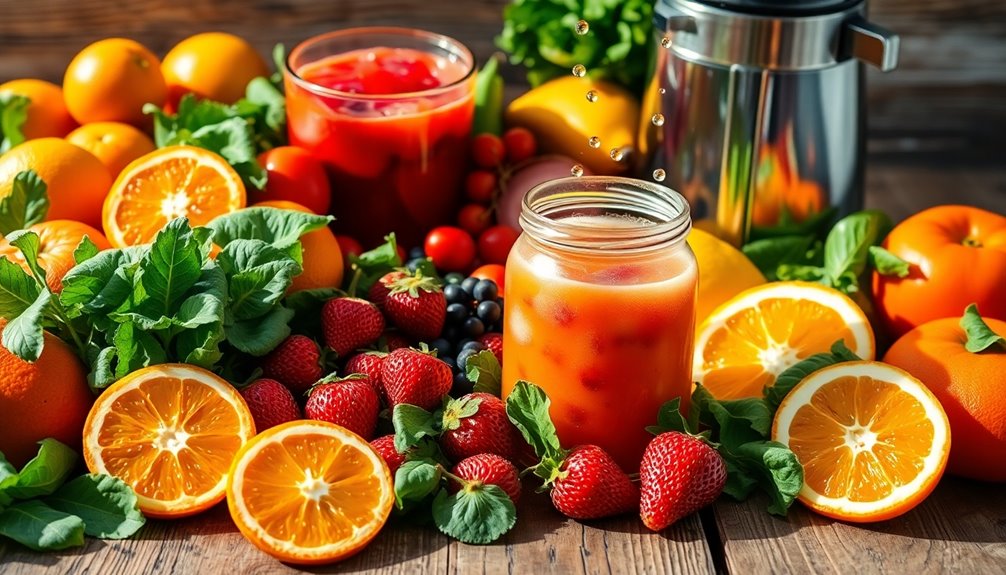
When you're ready to create your juice blend, think about the balance of flavors and nutritional benefits your ingredients can provide.
Start with a base of high-yield fruits or veggies like cucumbers or celery for volume. For sweetness, add apples or pears, and include tart elements like lemons for a zing. Juice offers different nutritional benefits when you choose your ingredients thoughtfully, such as the health benefits of parsley juice.
Combine earthy options like kale or beets for depth. You can mix fruits and vegetables, like pairing apples with carrots and ginger, to create unique flavors. Don't forget to experiment with herbs like basil or mint for an extra layer of freshness. Adjust sweetness to your taste using honey or sugar.
Finally, enjoy the process and tailor your blend to suit your preferences!
Strain If Necessary
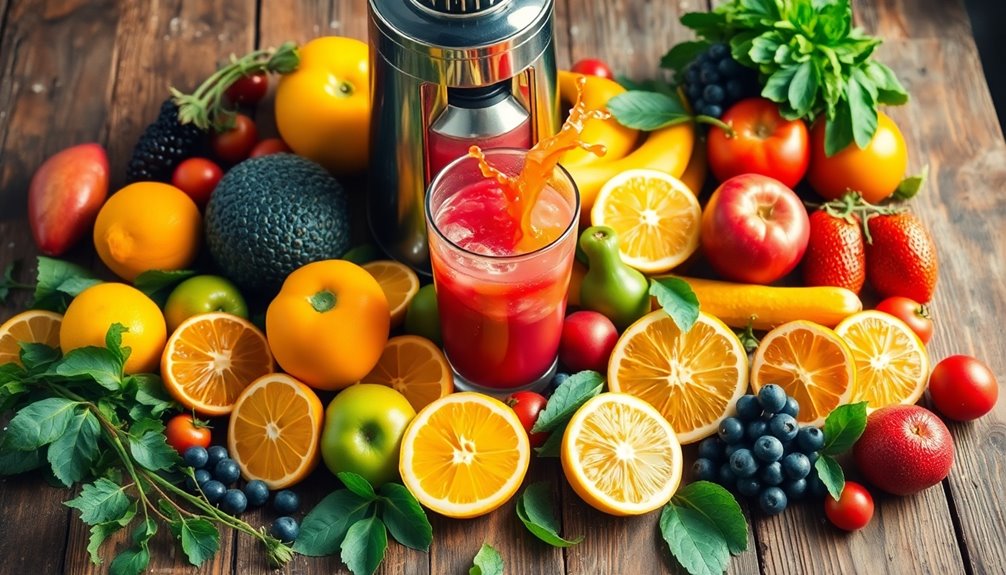
Straining your juice can significantly enhance its texture and flavor. By removing pulp and fiber, you'll create a smoother drink that's easier on your digestive system, especially during a cleanse. Straining also improves the juice's appearance, making it more visually appealing. You can use several methods: a fine-mesh strainer, a nut milk bag, or cheesecloth for effective filtration. Metal sieves work well for larger batches, while coffee filters provide finer results. Each tool has its benefits, from the reusable nut milk bag to the inexpensive fine-mesh strainers. Straining allows for better nutrient absorption without the fiber, making your juice more enjoyable and easier to store. This is particularly important because juicing bypasses digestion, allowing for immediate nutrient absorption. Additionally, opting for sustainable brands can enhance your overall health and environmental impact, as many focus on organic ingredients. So, don't skip this step if you want a delightful juice experience!
Store Your Juice Properly
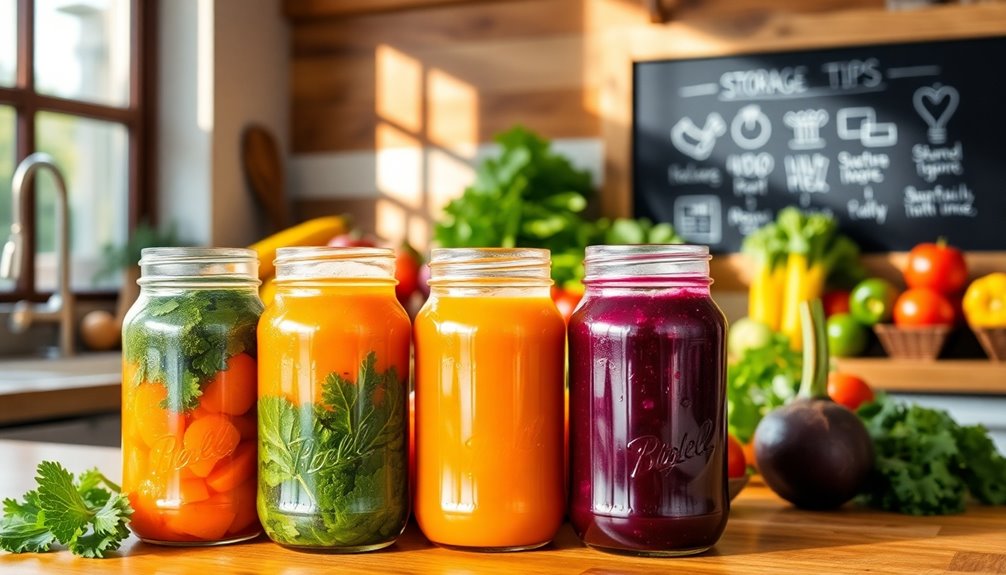
To keep your juice fresh and flavorful, it's crucial to store it properly right after making it. Use airtight glass containers to minimize oxidation and nutrient loss. Airtight containers limit juice exposure to oxygen, which is essential for maintaining its quality. Additionally, properly stored juice can help improve overall well-being by preserving its nutrient content.
Make sure your fridge temperature is between 35-40°F (1.6-4.4°C) for optimal freshness, and place the containers in the back for a consistent temperature. Fill them to the top to reduce air exposure, and if possible, use dark-colored containers to limit light exposure.
For longer storage, freeze your juice in small portions using glass containers or silicone ice trays. Leave about an inch of headspace for expansion.
Adding a small amount of lemon juice can naturally preserve your juice, enhancing its flavor while maintaining its nutrients. Enjoy your homemade juices by following these storage tips!
Enjoy Your Fresh Juice
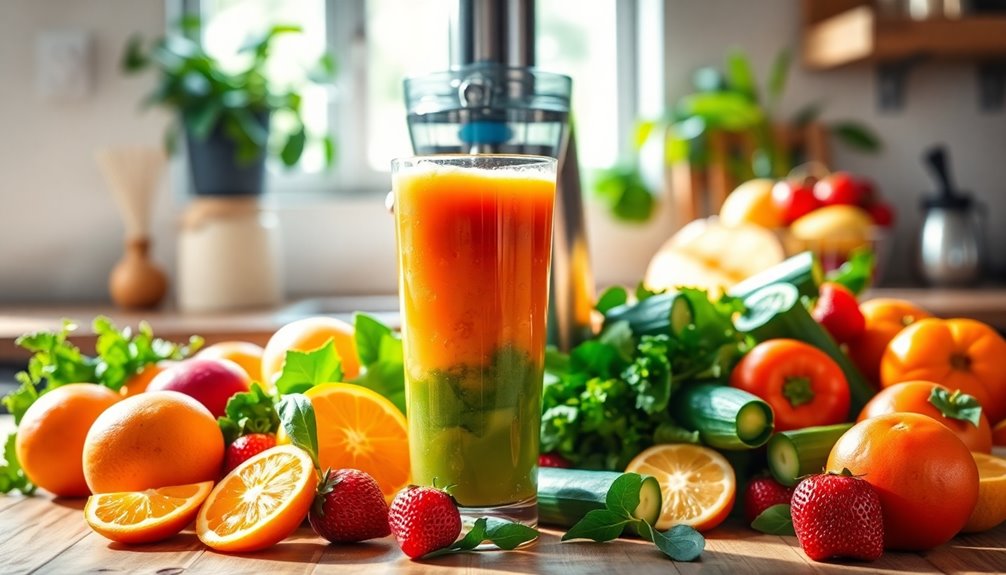
Fresh juice is more than just a refreshing drink; it's a powerhouse of nutrients that can elevate your health and wellness. Unlike commercial options, your homemade juice retains more vitamins, minerals, and enzymes, maximizing health benefits. Nutrient preservation ensures a full spectrum of health benefits from fruits and vegetables. Additionally, incorporating unique homemade fruit juice recipes allows you to explore diverse flavors and health advantages.
By using organic produce, you enjoy richer antioxidants while minimizing exposure to pesticides. Plus, juicing allows for quick nutrient absorption, giving your body a boost. You can fully customize flavors, experimenting with different fruits and herbs to create unique taste profiles. Want it sweeter? A touch of honey or stevia does the trick. Ripe fruits enhance both flavor and nutritional value.
Enjoying your fresh juice not only supports your health but also helps maintain a balanced diet loaded with essential nutrients. Cheers to that!
Experiment With New Recipes
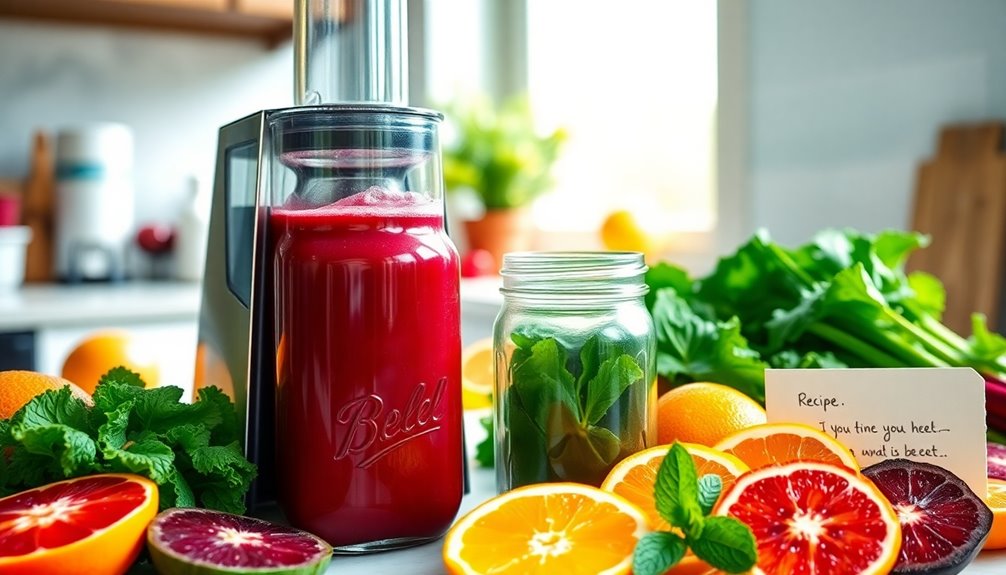
How can you elevate your juicing experience? Start by experimenting with new recipes!
Mix sweet fruits like apples and mangoes with tart fruits such as lemons or limes for a balanced flavor. Don't forget earthy options like beets or spinach, which can add depth. Incorporating fresh juice ensures you benefit from essential nutrients and vibrant flavors. Additionally, adding turmeric's anti-inflammatory properties can enhance the health benefits of your juice.
Try popular combinations like Beet Apple or detoxifying Berry Lemon juices. For a post-workout boost, blend tomato and grape for hydration.
Spice things up with ginger or turmeric for a kick. You can also swap ingredients—use carrots in place of beets or substitute oranges for pineapples.
Incorporating seasonal produce ensures freshness and variety. With trial and error, you'll discover your perfect juice creations and keep your routine exciting!
Frequently Asked Questions
Can I Mix Different Types of Juices Together?
Absolutely, you can mix different types of juices together!
Just remember to consider flavor balance—combine sweet, tart, earthy, or herbaceous juices for the best taste.
Stick to ingredients from the same category for more predictable results.
Don't forget about texture and nutritional balance, too.
Experiment with small batches to find your perfect blend.
Enjoy the process and have fun discovering new combinations that suit your taste and health goals!
How Do I Clean My Juicing Equipment Effectively?
To clean your juicing equipment effectively, start by washing all parts immediately after use.
Unplug the juicer and rinse components to prevent residue from drying.
For deep cleaning, soak parts overnight in a solution of baking soda and citric acid.
Use nylon brushes to scrub away pulp, and avoid abrasive materials on plastics.
Regularly sanitize and flush juice lines weekly to maintain hygiene, ensuring your equipment stays in top shape.
What Are the Best Storage Containers for Homemade Juice?
When storing your homemade juice, opt for glass containers, as they preserve taste and nutrients without leaching chemicals.
Avoid plastic, and consider stainless steel for durability. Use amber jars to shield juice from light degradation.
Ensure your containers have airtight lids to minimize spoilage, and fill them to the top to reduce oxidation.
If you're looking for eco-friendly options, recycled glass bottles work great too!
Always refrigerate or freeze for maximum freshness.
How Can I Make My Juice Last Longer?
To make your juice last longer, start by using fresh, whole produce and avoid pre-cut items.
Store your juice in airtight containers and keep it refrigerated to slow down spoilage. You can also freeze juice for extended shelf life.
Incorporating acidic ingredients like citrus can help preserve freshness.
Lastly, minimize opening the container frequently to reduce air exposure, and always maintain cleanliness during preparation and storage to prevent contamination.
Are There Any Common Juicing Mistakes to Avoid?
When you're juicing, it's crucial to avoid common mistakes. Make sure you wash your produce thoroughly to eliminate bacteria.
Choose high-quality, organic ingredients, and balance your fruits with plenty of vegetables.
Don't overlook the importance of variety; mixing flavors keeps things interesting and nutritious.
Also, pay attention to your juicer's settings and storage methods to maintain freshness.
Lastly, drink your juice mindfully, allowing your body to absorb those nutrients effectively.
Conclusion
Now that you've mastered the art of homemade organic juices, get ready to enjoy a nutritious boost! Did you know that drinking just one glass of fresh juice can provide you with up to two servings of fruits and vegetables? With your equipment gathered and fresh ingredients prepped, the possibilities are endless. So, keep experimenting with new recipes and flavors to find your favorites. Cheers to your health and delicious homemade creations!
Cindy thoroughly researches juicing trends, techniques, and recipes to provide readers with practical advice and inspiration. Her writing style is accessible, engaging, and designed to make complex concepts easy to understand. Cindy’s dedication to promoting the advantages of juicing shines through her work, empowering readers to make positive changes in their lives through the simple act of juicing.

